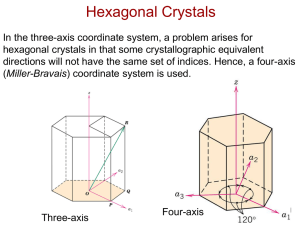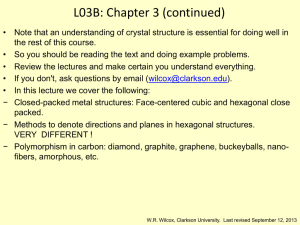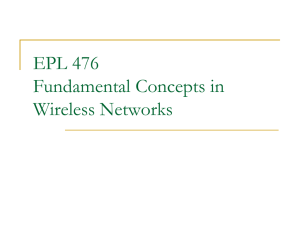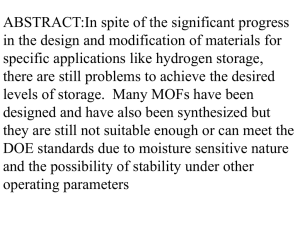Structural Influence on the reduction and catalytic behaviour of
advertisement
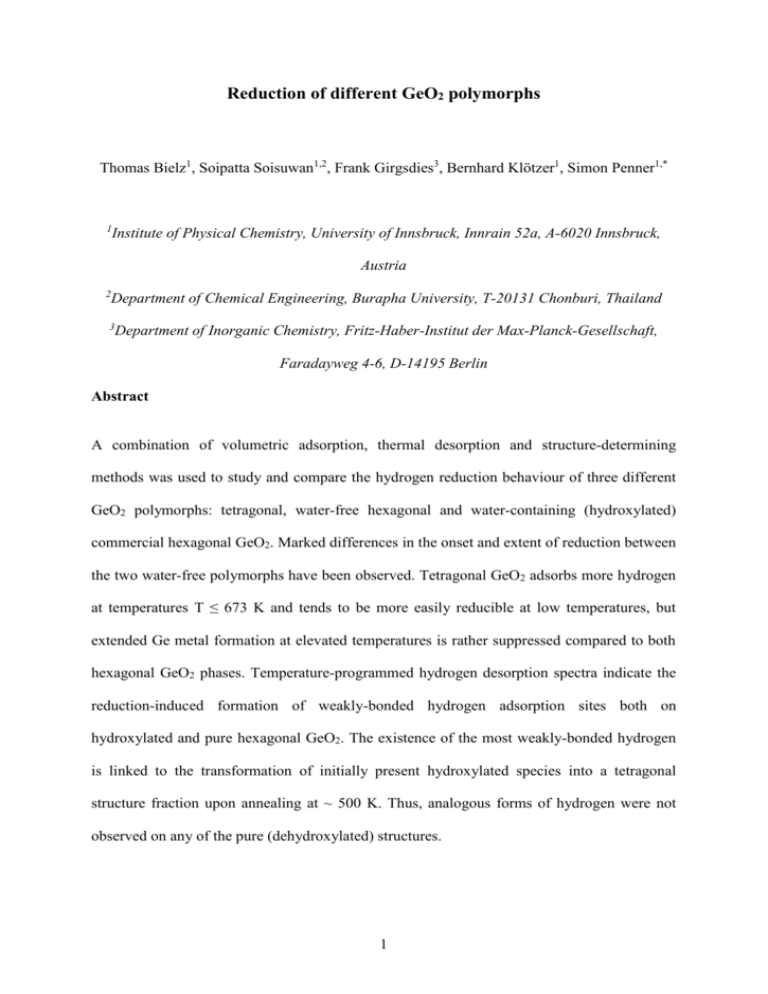
Reduction of different GeO2 polymorphs Thomas Bielz1, Soipatta Soisuwan1,2, Frank Girgsdies3, Bernhard Klötzer1, Simon Penner1,* 1 Institute of Physical Chemistry, University of Innsbruck, Innrain 52a, A-6020 Innsbruck, Austria 2 Department of Chemical Engineering, Burapha University, T-20131 Chonburi, Thailand 3 Department of Inorganic Chemistry, Fritz-Haber-Institut der Max-Planck-Gesellschaft, Faradayweg 4-6, D-14195 Berlin Abstract A combination of volumetric adsorption, thermal desorption and structure-determining methods was used to study and compare the hydrogen reduction behaviour of three different GeO2 polymorphs: tetragonal, water-free hexagonal and water-containing (hydroxylated) commercial hexagonal GeO2. Marked differences in the onset and extent of reduction between the two water-free polymorphs have been observed. Tetragonal GeO2 adsorbs more hydrogen at temperatures T ≤ 673 K and tends to be more easily reducible at low temperatures, but extended Ge metal formation at elevated temperatures is rather suppressed compared to both hexagonal GeO2 phases. Temperature-programmed hydrogen desorption spectra indicate the reduction-induced formation of weakly-bonded hydrogen adsorption sites both on hydroxylated and pure hexagonal GeO2. The existence of the most weakly-bonded hydrogen is linked to the transformation of initially present hydroxylated species into a tetragonal structure fraction upon annealing at ~ 500 K. Thus, analogous forms of hydrogen were not observed on any of the pure (dehydroxylated) structures. 1 Keywords: Volumetric adsorption, In-situ X-ray diffraction, Hydrogen desorption, Phase transformation, Temperature-programmed desorption, Temperature-programmed oxidation *Corresponding author: simon.penner@uibk.ac.at, Tel: 00435125075056, Fax: 00435125072925 2 1. Introduction GeO2 has attracted recent interest in various research fields due to its outstanding physicochemical properties. For materials chemistry and optoelectronics-related work, high thermal stability, appropriate dielectric properties and refractive optical properties are most notable1-4. Interdisciplinary studies on GeO2 are also important to bridge the gap between petrographic and chemical research, since GeO2 - due to its close structural analogy to SiO2 - is an obvious choice to simulate the transformation of different quartz phases occurring at high temperatures and pressures1,5-7. The most crucial structural parameter significantly influencing these properties is the already well-known and -studied polymorphism. GeO2 exists in a hexagonal (tetrahedrally coordinated Ge) and a tetragonal (octahedrally coordinated Ge) modification1,8-10. The tetragonal structure is the stable phase under ambient conditions and transforms into the metastable hexagonal modification at 1306 K11. The tetragonal modification represents a denser network of Ge-O entities (density 6.239 g cm-3) compared to the hexagonal structure (density 4.288 g cm-3)5,7. Moreover, the hexagonal phase is slightly soluble in water (0.4 g/100 g H2O at 300 K), whereas the tetragonal structure is practically insoluble11. These differing structural properties very likely induce associated changes in the chemical and materials properties and in turn also affect possible applications of both modifications. With respect to catalysis, some hints have already been given in previous results of some authors of the present contribution concerning the use of different GeO2 polymorphs as suitable supports for Pd and Pd-Ge catalyst particles12. In this respect, a different reduction-and hence, a different “strong metal-support interaction” (SMSI) behaviour, of both modifications has been inferred from studies on the reductive formation of different Pd-Ge bimetallic phases. Tetragonal GeO2 was identified to act as a typical SMSI oxide, that is, reversible formation of mobile sub-stoichiometric GeOx species encapsulating the Pd and Pd-Ge particles was observed12. In contrast no such behaviour was observed if commercial hexagonal GeO2 was used as support. 3 The primary aim of this study therefore is to compare the reducibility of the pure hexagonal and tetragonal GeO2 modifications in order to gain deeper insight into the already established different behaviour as a catalyst support. A combination of temperature-programmed volumetric adsorption and desorption techniques (temperature-programmed reduction (TPR), -oxidation (TPO) and -desorption (TPD)) to study the formation and reactivity of oxygendeficient states and structure-determining methods (ex- and in-situ X-ray diffraction (XRD)) was employed to fulfil this task. Special attention was also paid to the comparison of hydroxylated commercial, only initially “XRD-phase-pure” hexagonal GeO2 (containing a considerable amount of water within its structural entities) and a corresponding water-free hexagonal GeO2 sample. This is of crucial importance, since the commercial sample is prone to lose water upon annealing to ~ 400 K and a small part of the structure is inherently transformed into the tetragonal modification, implying uncontrolled changes in its physicochemical properties13. 2. Experimental 2.1. Materials Hydroxylated commercial hexagonal GeO2 powder (Alfa Aesar, 99.9999%) was used as delivered. Tetragonal GeO2 was prepared starting from the hexagonal phase by impregnating the latter with an aqueous RbOH solution (molar ratio hexagonal GeO2: RbOH = 99.995:0.005) at 298 K, followed by drying at 373 K for 12 h. Subsequent annealing at 1263 K for 36 h yielded full conversion into the tetragonal phase. The details of the preparation process of the tetragonal modification has been described in detail elsewhere13 The phase purity of both modifications was determined by ex-situ X-ray diffraction, conforming very well with literature-reported diffractograms.4,9,14 For preparation of waterfree, phase pure hexagonal GeO2, the commercial hexagonal powder was heated to the melting point and kept at 1423 K for 2.5 h (heating rate up to 1423 K 10°C/min). After 2.5 h, 4 the temperature was decreased in 20 minutes to 1323 K and the sample left at this temperature for another 67.5 h7 to induce complete crystallization. After quenching the sample to 298 K, phase-pure hexagonal GeO2, not undergoing transformation to tetragonal GeO2 upon lowtemperature (~500K) annealing was obtained. The chemical composition was checked by Xray photoelectron spectroscopy, which only showed peaks due to Ge and O with all other impurities below the detection limit. Surface area analysis by BET yielded for all three studied polymorphs surface areas below 1 m2/g. 2.2. Volumetric Adsorption The volumetric measurements were performed in an all-quartz apparatus15 equipped with metal bellow valves (Witeg), a Baratron pressure transducer (MKS), and mass flow controllers (MKS) and a Balzers QMA125 quadrupole mass analyzer. The furnace was a Linn model operating up to 1500 K. For reduction prior to the temperature-programmed H2 desorption measurements, the samples were treated for 1 hour in 1 bar flowing dry hydrogen at a typical flow rate of 60 ml/min at different temperatures (473 K-773 K). After that the sample was evacuated at room temperature down to a base pressure of about 5x10-7 mbar. For the temperature-programmed H2 desorption measurements heating in high vacuum to 923 K at a rate of 10 K/min was performed with simultaneous mass spectrometry detection, followed by cooling in vacuum to 313 K. The subsequent temperature-programmed oxidation (TPO) measurements involving a heating-cooling cycle between 300 K and 923 K allowed us to study the re-oxidation process and the amount of oxygen required for complete O2-quenching of reduced Ge centers. These were started with an initial pressure of 100 mbar dry oxygen. The corresponding volumetric temperature-programmed reductions (TPR) were also performed with an initial H2 pressure of 100 mbar hydrogen with a programmed heating- 5 cooling cycle between 300 K and 673 K or between 300 K and 873 K at a heating and cooling rate of 10 K/min. 2.3. X-ray Diffraction Ex-situ powder X-ray diffraction experiments were performed under ambient conditions using a Siemens D5000 diffractometer and Cu-Kα radiation (1.54178 Å) at 300 K in the 2 range 10 to 70°. The in-situ XRD data were collected on a STOE Theta/theta X-ray diffractometer (CuKα1+2 radiation, secondary graphite monochromator, scintillation counter) equipped with an Anton Paar XRK 900 in-situ reactor chamber. The gas feed was mixed by means of Bronkhorst mass flow controllers, using helium as inert balance gas at a total flow rate of 100 ml/min. The effluent gas composition was monitored with a Pfeiffer OmniStar quadrupole mass spectrometer. Before and after the reduction program, each sample was characterized at 25 °C with a slow XRD scan (19–75° 2 with 0.02° steps, counting time: 10 s/step). During the reduction in 25% H2, faster scans (1s/step counting time) were performed. The samples were heated to 300 °C at an initial rate of 10 °C/min, then isothermal XRD scans were recorded every 20 °C between 300 and 600 °C with intermediate heating ramps of 5 °C/min. After the scan at 600 °C, the samples were cooled to 25 °C at a rate of 10 °C/min. All XRD data were analyzed by full pattern fitting according to the Rietveld method using the program TOPAS [TOPAS version 3, copyright 1999, 2000 Bruker AXS]. This method yields a fair estimate of the crystalline phase composition, assuming the absence of significant amounts of amorphous material. The weight fractions of the phases yielded by the software have been re-calculated into molar fractions in order to reflect the progress of reduction. A representative example of the Rietveld analysis is shown in Figure 1 (see below). 6 3. Results 3.1. Structural characterization by In-situ X-ray diffraction (In-situ XRD) and Scanning Electron Microscopy (SEM) In-situ XRD experiments were performed with the primary aim to exactly determine the structural onset of reduction in hydrogen, that is, to verify the formation of Ge metal and changes of lattice parameters due to bulk defect formation and possibly, also germanium oxides in lower valence states, which might be intermediate structures in the course of reduction to the partly metallic state. These experiments have been performed on all three samples under identical conditions and also verified by corresponding ex-situ experiments. To illustrate the analysis procedure, Figure 1 A highlights a comparison of the measured (blue) with the calculated diffractogram (red) of water-containing hexagonal GeO2 after reduction at 500 °C alongside the difference pattern (gray, with negative offset). Thick marks indicate the positions of reflections from the tetragonal GeO2 (blue), Ge metal (black) and hexagonal GeO2 (cyan) phases. In Figure 1 B, the fitting routine of the Rietveld method is exemplified. It shows the same spectrum as above, but with calculated contributions of the separate phases. For the sake of clarity, only the 2θ region between 35 and 55° is shown. Subsequently, Figure 2 indicates the quantitative analysis of the X-ray diffractograms (cf. Figure 1 and Supporting Information S1 A-C), plotted as mole fraction oxide or metal versus reduction temperature. Panel A exhibits these experiments for the tetragonal structure. At ~ 730 K, the amount of oxide starts to decrease, correspondingly the amount of Ge metal increases. At 873 K, ~ 68% of the tetragonal phase has been converted into Ge metal. As a guide to the eye, the temperature of ~850 K after which a 50:50% composition of oxide:metal was obtained, has been marked. No complete transformation or the presence of intermediate (suboxidic) phases was observed during this experiment. For the pure hexagonal GeO2 phase 7 (panel B), reduction starts at roughly the same temperature, but reduction at 873 K results in 100% conversion of the oxide structure into Ge metal. The 50:50 ratio is observed already at ~800 K on this sample. The analogous experiment on the hydroxylated commercial hexagonal phase yields Ge metal formation at around ~750 K, that is, at slightly higher temperatures than observed on the pure tetragonal and hexagonal phases, and a 50:50 ratio at again ~800 K. As it has been observed before, the situation is more complicated due to the possible dehydration of amorphous hydroxylated Ge species to the tetragonal GeO2 phase or a possible partial transformation of the hexagonal into the tetragonal GeO2 modification13. However, in striking contrast to the experiments on the tetragonal phase, but similar to the pure hexagonal phase, complete transformation into the Ge metal phase has been obtained at T ≥ 850 K (we attribute the shift of onset of reduction to the metal in case C to the in parallel formation of tetragonal GeO2, which has been shown to proceed via two steps in the temperature range 500 – 800 K13). Obviously, as the sum of both GeO2 signals approaches zero at ~ 850 K, also the fraction of tetragonal GeO2 phase initially present at ~ 750 K is converted into Ge metal at temperatures T > 800 K. Note that the signal of the hexagonal GeO2 phase in panel C decreases already between 500 and 750 K, as the reduction temperature is increased, and that due to the partial phase transformation the signal of the tetragonal phase accordingly increases. These experiments were generally corroborated by the corresponding ex-situ experiments, which also showed that any of the reduction-induced changes (unlike the phase transformation induced) are fully reversible upon an oxidative treatment in flowing oxygen at 873 K and the system returns to its predominant oxidic starting structure. Concerning contributions of surface defects to the observed reducibility differences we note that due to the preparation history (i.e. long annealing times at high temperatures), the surfaces are inherently not very prone to exhibit defects and without exception show very small specific areas (around 0.5 m2/g). 8 The structural changes, especially at high temperatures, are also obvious from the related SEM images. Figure 3 shows a representative comparison of grains of hydroxylated commercial hexagonal GeO2 before the metal formation after reduction at 573 K (1h, A) and after reduction at 873 K (1h, B). Loss of the straight particle edges accompanied by considerable sintering is easily observed and points to increased mobility of particles and reduced species. Since XRD diffractograms prove the presence of 100% metallic Ge at 873 K, the question arises, if Ge metal is also dominant in the SEM images. It has been reported that Ge precipitates from the hexagonal phase as black crystalline aggregates at T ≤ 1023 K without exhibiting distinct crystal facets16,17. At high reduction temperatures, these aggregates appeared to be increasingly embedded in residual crystalline GeO2, with no pronounced morphological difference between GeO2 and Ge. We note, however, that these experiments were conducted under static conditions in a fused quartz vial16,17. Thus, any water which is inevitably formed by oxide reduction at these high temperatures remains inside the vial and likely, the reduction is much less pronounced due to reversible re-oxidation of Ge metal by water. In our view, this explains why almost no changes in crystal habitus between hexagonal GeO2 and Ge metal were observed (and no substantial changes in the habitus in general) in ref.16,17. We therefore suggest that the reduction under flowing hydrogen highlighted in Figure 3 is much more pronounced and sintered aggregates of both Ge metal and possibly some remaining (reduced) GeO2 are present. The morphological discrimination of both structures (metal vs. reduced oxide) is thus not straightforward in this heavily reduced state. 3.2. Temperature-programmed reduction (TPR) Panel A of Figure 4 shows the TPR experiments on the three different GeO2 samples from 300 to 673K. Up to 673 K, pure hexagonal GeO2 shows only a small hydrogen uptake (~ 1 µmol/g) and almost no isothermal uptake at the highest temperature (held for 10 minutes). 9 The trace of the commercial hexagonal GeO2 follows a similar trend with the one exception of a little higher initial uptake (~ 1.5 µmol/g) between 300 and 400 K, which can be interpreted in terms of weakly-bonded hydrogen related to the presence of the “low-temperature tetragonal phase” fraction (and its interface to the hexagonal majority fraction) formed after partial phase transformation at ~ 400 K. This result fits nicely to the corresponding lowtemperature hydrogen desorption feature shown in Figure 5C, which is also clearly linked to the presence of this phase. In contrast, the tetragonal phase shows a distinctly different behaviour. Up to 673 K, the tetragonal sample takes up about 2 µmol/g of hydrogen, with a subsequent pronounced isothermal uptake at 673 K, leading to a final value of 5.5 µmol/g hydrogen uptake after cooling down. The lower panel B of Figure 4 highlights the corresponding TPR experiments up to 873 K. As it can be clearly seen, the major hydrogen uptake of the tetragonal sample starts at significantly lower temperatures (~ 600 K) compared to both hexagonal samples (~ 750 K). Above ~ 750 K, the uptake of hydrogen on the tetragonal sample is strongly accelerated and finally results in ~ 29 µmol/g hydrogen uptake. The corresponding uptake curves of both hexagonal samples are almost identical and show strong acceleration at ~ 800 K, finally leading to ~ 22 µmol/g hydrogen uptake. In contrast to the tetragonal modification, which only shows a small isothermal uptake during 10 minutes at 873 K, the amount of additional isothermally adsorbed hydrogen at 873 K (also 10 minutes) for both hexagonal phases is much higher. This points to prevalent kinetic limitations in the reduction process of the hexagonal polymorphs and reflects the strong difference in kinetic reducibility of tetragonal and hexagonal GeO2, already being obvious from Figure 4A. During cooling, the total amount of hydrogen remained almost constant for all three considered GeO2 modifications. The results indicate that hydrogen adsorption on these phases is an activated process in the whole studied temperature region and kinetic limitations, although of different extent, are still prevalent in all cases. A true adsorption 10 equilibrium is therefore not yet established with the gas phase. To clarify this point, activation energies for the reduction processes were extracted from the temperature-programmed reduction experiments of Figure 4. An Arrhenius plot ln [reaction rate (in µmol g-1 s-1)] versus 1/T (in K) yields apparent activation energies of ~ 85 kJ/mole for the tetragonal and ~ 105 kJ/mole for the commercial hexagonal sample. This is, however, in contrast to the formation enthalpies of the two modifications, which are (at 1308 K) -507 kJ/mole for the tetragonal and -486 kJ/mole for the hexagonal modification. This once more emphasizes the necessity to include kinetic limitations in the discussion of the reduction processes. 3.3. Temperature-programmed desorption (TPD) In order to gain insight into the energetic nature of the hydrogen adsorption sites, temperatureprogrammed desorption experiments have been additionally carried out on all three samples. Starting out with the tetragonal sample, we note that after hydrogen adsorption at 473 K, adsorbed H2 leaves the surface largely as H2O during TPD (Figure 5D, desorption maximum at ~575 K). Such low-temperature water desorption states are in fact only present on tetragonal GeO2. Obviously, a reaction channel exists, where hydrogen can exclusively desorb via water, which necessarily leads to a reduced final state of the sample. After 673 K reduction, more desorbed hydrogen is observed (peak maximum at ~710 K, Figure 5A), but even more water is formed (peak maximum at ~ 760 K, Figure 5D). Only after 773 K reduction this trend is inverted. A strong increase in hydrogen desorption (peak maximum at ~660 K) relative to water, which now exhibits two desorption maxima (at ~650 K and ~800 K), is observed. The 650 K - 660 K desorption features of hydrogen and water (Figure 5A and 5D) appear to be kinetically linked (possibly via OH species either reversibly releasing H2 or reacting towards H2O). Since the in-situ XRD experiments (Figure 2) revealed that after 773 K reduction a considerable amount of reduced Ge centres and even Ge metal are 11 formed, the relative increase in hydrogen desorption must be linked to the presence of such strongly reduced Ge species. As a general observation, tetragonal GeO2 shows considerably enhanced water formation relative to both hexagonal samples also during the TPD measurements, again indicating its kinetically enhanced reducibility. Easier reducibility of the tetragonal modification was already highlighted in Figure 2 (in-situ XRD) and Figure 4 (hydrogen TPR). In comparison, the hydrogen desorption propensity of both hexagonal samples is strongly enhanced (relative to water) at low temperatures (Figure 5B/C and 5E/F). The pure hexagonal sample exhibits pronounced desorption features at ~ 550 K and ~670 K. In contrast to tetragonal GeO2, no water desorption states are present below ~650 K (Figure 5E and F). This indicates that only the hexagonal modifications exhibit low-temperature desorption channels for hydrogen molecules, which do not affect the final oxidation states of the samples via water loss. In addition to the weakly bound adsorption state of hydrogen existing both on the pure and the hydroxylated hexagonal samples at ~ 550 K, the latter exhibits even more weakly bound hydrogen desorbing at around ~ 450 K. As already mentioned, this sample is not only affected by (initial) hydroxylation, but also by the presence of a certain amount of “lowtemperature” tetragonal phase. Consequently, we assign these states to specific sites created by the dehydroxylation-induced partial phase transformation towards the “low-temperature” tetragonal GeO2 domains. Whether the presence of these (and/or their interface to the hexagonal “surroundings”) domains is also responsible for the very pronounced hightemperature hydrogen desorption state at ~ 770 K observed only on the hydroxylated sample after reduction at 773 K (Figure 5F), remains an open question. In summary, also the TPD results suggest a strongly promoted “kinetic” reducibility of tetragonal GeO2, which may be of paramount importance for the promotion of water-forming catalytic hydrogenation reactions. Again, considerable contributions from defects are basically ruled out, since hydrogen desorption from defects would be observed at higher 12 temperatures (due to the stronger binding at defects). In contrast, all hydrogen TPD spectra basically show desorption features below ~ 700 K. An alternative way to study the degree of reduction of GeO2 after hydrogen reduction is the titration of reduced Ge centers with oxygen after the respective TPD experiments. For these measurements, about 100 mbar dry oxygen was admitted at 300 K to the volumetric cell, and subsequently the sample was heated up to 773 K (heating rate: 10 K/min). Figure 6 summarizes these experiments for all three modifications. Almost no oxygen re-uptake was measured on any of the three samples up to 570 K, which shows that hydrogen bonding and desorption below this temperature takes place without substantial reduction of lattice oxygen. Between 570 and 670 K a small oxygen uptake was detected for the pure samples (up to about 15 µmol/g), but somewhat less oxygen was taken up on the hydroxylated hexagonal GeO2 sample. Above 670 K, oxygen uptake strongly increased on all materials and finally reached about 90-120 µmol/g at 773 K. If the oxygen uptake is normalized to the surface area, leading to ~ 10-15 µmol/m2 uptake between 570 and 670 K and 160-180 µmol/m2 above 673 K, respectively, and these values are compared to the ones required for one monolayer (estimated from the density of the two GeO2 polymorphs and the surface concentration of GeO2 entities to be 18.08 µmol/m2 for the tetragonal polymorph and 14.08 µmol/m2 for the hexagonal polymorph, respectively), it is obvious that – corroborating the XRD experiments – the reduction is not limited to the surface, but bulk reduction (and hence Ge metal formation) is observed. As has been shown in section 3.1., this is the temperature, where Ge metal formation starts, i.e. the oxide is already in a deeply reduced state, as now confirmed by the oxygen re-uptake measurements. At the highest temperature, we note a small difference in oxygen re-uptake between the hexagonal and the tetragonal structure, i.e. the tetragonal modification takes up about 10 µmol/g less oxygen after the same reduction treatment. As discussed in section 3.1., this could be due to a less reduced state at the highest reduction temperatures (873 K) for the tetragonal sample. 13 We emphasize at this point, that all the samples showed full re-oxidation toward the initially predominant GeO2 modification after the oxygen re-uptake experiments, and moreover, that ex-situ XRD measurements taken after the re-oxidation only showed peaks due to the respective pure oxides, but no residual Ge metal (or any sub-stoichiometric oxide), as shown in Figure 7. Panel A shows these data for the tetragonal, panel B for the commercial hexagonal sample. Note the small amount of the tetragonal phase after annealing the hexagonal phase, which is possibly due to dehydration of amorphous GeOH-species to the thermodynamically more stable tetragonal phase. It appears that also in the case of the reoxidation of the tetragonal modification a very small amount is transformed into the hexagonal phase. This indicates that Ge metal formation is completely reversible and also the respective original oxygen modification is quantitatively restored during re-oxidation. Obviously, nucleation of the alternative GeO2 polymorph is almost entirely suppressed and the presence of the interface between Ge metal and the original oxide modification strongly dominates the re-oxidation process. 4. Discussion of the reduction behaviour From the previously published literature one can deduce, that the reduction of GeO2 involves volatile GeO species and that deeper reduction leads to varying amounts of Ge metal16,17. However, the detailed mechanism of reduction very much depends on the exact experimental conditions, that is, e.g. reduction temperature and hydrogen partial pressure16,17. These parameters determine the amount of Ge metal formed. Another factor that has to be considered is the propensity of water to quench reduced Ge centers generated by the reduction18. This has been observed for a range of other oxides15,19 and is also valid for GeO2: also in our experiments no metal formation has been observed after the temperatureprogrammed reduction experiments (no water removed; static conditions). In contrast, 14 reduction under flowing conditions (water continuously removed; hydrogen desorption experiments, in-situ XRD experiments) leads to much deeper reduction. Another point which has not been given the amount of attention it obviously deserves is the influence of the water content of hexagonal GeO2 fabricated from hydroxylated precursors13 on reducibility. These residual hydroxylated species indirectly obscure the reduction properties of the commercial hexagonal modification, due to the inevitable partial (trans-)formation into the tetragonal structure. Clear hints for an eventually different reduction behaviour of various GeO2 modifications have been given previously by comparative studies of hexagonal and amorphous GeO2 phases. A different kinetic behaviour has been mainly addressed to different surface active sites, which catalyse the formation and growth of nuclei. Obviously, glass formation and crystallization phenomena have been found to play a major role20,21. In extension of previous literature results focussing on the different reducibility of crystalline hexagonal and amorphous GeO2, we emphasize the strong influence of the specific preparation process on reducibility and hydrogen bonding properties. Clear differences in the reduction behaviour not only between the two pure GeO2 modifications, but especially also between a commercially available and hydroxylated and a phase-pure and water-free hexagonal structure have been observed, alongside with the formation of special interface sites on the latter, which are not observed on the pure structures. 5. Conclusions The presented results are in line with already well-known concepts developed e.g. on different TiO2 polymorphs (i.e. rutile vs. anatase)22-26, which show entirely different behaviour when used as supporting oxides in catalytic experiments22,23 and exhibit different materials or sensor properties24. It has been stated that the anatase form of TiO2 is found to be more difficult to reduce than its rutile counterpart, which has been addressed to a disfavoured 15 electron transfer to Ti for the former, as inferred from the relative shift of the conduction band. This also goes along with different hydrogenated structures25. Slight differences in the onset of reduction have also been observed for the carbothermic reduction26. In general, it appears that tetragonal GeO2 is placed in a line with other rutile-type oxides such as SnO2 or RuO2, where an enhanced kinetic surface reducibility of the associated tetragonal structure has been observed27,28. Especially for the latter, the “O-rich” (110) surface has been identified as the catalytically active phase, due the presence of coordinatively unsaturated Ru atoms and bridging oxygen in close vicinity. We for the first time show that similar concepts can also be applied to the different GeO2 polymorphs, where clear indications of an enhanced kinetic surface reducibility of the tetragonal rutile-type polymorph have clearly been demonstrated. The presented results might therefore trigger and motivate similar surface science studies of e.g. the GeO2 (110) surface with respect to the different reducibility of bridging or in-plane oxygen. In addition, these results offer a basis to reliably interpret the differences in (strong) metalsupport interaction (SMSI) observed when using different GeO2 polymorphs as supports for e.g. Pd particles. The presented results allow to explain why especially tetragonal GeO2 is likely to behave more like a typical “SMSI”-oxide, as already shown in ref.12, due to its kinetically enhanced redox activity. 6. Acknowledgements We thank the Austrian Science Foundation for financial support under project F4503-N16. S. Soisuwan thanks the Erasmus Mundus External Cooperation Window Program-Bridging the Gap for financial support. This work was also financially supported by the Austrian Ministry of Science (BMWF) as part of the Uni-Infrastrukturprogramm of the Forschungsplattform 16 Scientific Computing at LFU Innsbruck and has been performed within the framework of the Forschungsplattform Materials- and Nanoscience. Supporting Information Available A Temperature-dependent in-situ X-ray diffraction patterns taken in H2/He (Gas flow: 25% at 100 ml/min total flow) between 573 and 873 K on tetragonal (panel A), pure hexagonal (panel B) and water-containing, as-delivered hexagonal GeO2 (panel C). This material is available free of charge via the internet http://pubs.acs.org Figure Captions Figure 1: Representative X-ray diffractogram of water-containing hexagonal GeO2 after insitu reduction in hydrogen with a comparison of the measured (blue) and calculated (red) diffractogram. The difference pattern (gray) is shown with negative offset (panel A). Thick marks indicate the positions of reflections from the tetragonal GeO2 (blue), Ge metal (black) and hexagonal GeO2 phases (cyan). In panel B, the fitting routine of the Rietveld analysis is exemplified for the diffractogram of panel A, but for the sake of clarity, only the region between 2θ 35-55° is shown. Calculated contributions of the separate tetragonal GeO2, Ge 17 metal and hexagonal GeO2 phases are therefore highlighted with the same colors as in panel A. Figure 2: Phase analysis of the in-situ XRD experiments in hydrogen, plotted as mole fraction of hexagonal or tetragonal GeO2 and Ge metal versus reduction temperature: tetragonal GeO2 (panel A), pure hexagonal GeO2 without water (panel B) and hydroxylated commercial hexagonal GeO2 (panel C). Gas flow: 25% H2 in He at 100 ml/min total flow. The corresponding XRD patterns are shown in the Supporting Information in Figure S1 A-C. Figure 3: Representative scanning electron microscopy images of the hydroxylated commercial hexagonal GeO2 sample after reduction in 1 bar flowing hydrogen for 1 h at 573 K (A) and 873 K (B). Figure 4: Volumetric hydrogen adsorption during a temperature-programmed reduction (TPR) heating and cooling cycle between 300 K and 673 K (panel A) and 873 K (panel B) for three different GeO2 samples: pure hexagonal GeO2 (water-free; red), hexagonal GeO2 (hydroxylated commercial; green) and tetragonal GeO2 (blue). The samples were exposed to about 100 mbar initial H2 pressure at 300 K before the ramp was started. Linear heating and cooling rate: 10 K/min. Isothermal period: 10 minutes at the respective maximum temperatures. Figure 5: Temperature-programmed hydrogen and water desorption spectra as a function of pre-reduction temperature. The hydrogen desorption is shown in panel A-C, the water desorption in panel D-F: tetragonal GeO2 (upper panel A und D), pure hexagonal GeO2 (middle panel B and E) and hydroxylated commercial hexagonal GeO2 (lower panel C and F). 18 Linear heating and cooling rates of 10 K/min were applied. Reduction was carried out at each temperature for 1 h in 1 ml/s flowing, dry hydrogen (liquid nitrogen water trap). Figure 6: After each TPD run, the samples were subjected to temperature-programmed reoxidation (TPO) in static oxygen (~ 200 mbar) up to 923 K. The oxygen re-uptake was quantified as a function of pre-reduction in hydrogen for tetragonal (blue triangles), pure hexagonal (without water, red filled circles) and hexagonal hydroxylated GeO2 (green open circles). Figure 7: Overview ex-situ XRD spectra of the tetragonal (panel A) and commercial hexagonal GeO2 samples (panel B) after different reduction and re-oxidation treatments. For clarification, the respective XRD spectra of the initial hexagonal and tetragonal samples are also indicated. 19 References [1] Scott, J. F., Phys. Rev. B 1970, 1(8), 3488-3493 [2] Ardyanin, M.; Rinnert, H.; Vergnat, M. J. Lumin. 2009, 129, 729-733 [3] Terakado, N.; Tanaka, K. J. Non-Cryst. Solids 2006, 352, 3815 [4] Atuchin, V. V.; Gavrilova, T. A.; Gromilov, S. A.; Kostrovsky, V. G.; Pokrovsky, L. D.; Troitskaya, I. B.; Vemuri, R. S.; Carbajal-Franco, G.; Ramana, C. V. Cryst. Growth Des. 2009, 9(4), 1829; Ramana, C.V.; Carbajal-Franco, G; Vemuri, R.S; Troitskaya, I. B.; Gromilov, S. A.; Atuchin, V. V. Mat. Sci. Eng. B 2010, 174, 279-284 and references therein [5] Gillet, P.; Le Cleac’h, A; Madon, M J. Geophys. Res. 1990, 95, 21635-21655 [6] Haines, J.; Cambon, O.; Phillipot, E.; Chapon, L.; Hull S. J. Solid State Chem. 2002, 166, 434-441 [7] Mernagh, T.P.; Liu, L Phys Chem Minerals 1997, 24, 7-16 [8] Bolzan, A. A.; Fong, C.; Kennedy, B. J.; Howard, C. J. Acta Crystallogr. Sect. B 1997, 53, 373-380 [9] Baur, W. H.; Khan, A. A. Acta Crystallogr. Sect. B 1971, 27, 2133-2139 [10] Prakapenka, V. P.; Shen, G.; Dubrovinsky, L. S.; Rivers, M. L.; Sutton, S. R. J. Phys. Chem. Solids, 2004, 65, 1537-1545 [11] Hollemann ,A. F.; Wiberg, E. Lehrbuch der Anorganischen Chemie, Walter deGruyter, Berlin, 2007 [12] Lorenz, H.; Zhao, Q.; Turner, S.; Lebedev, O.; van Tendeloo, G.; Pfaller, K.; Rameshan, C.; Konzett, J.; Klötzer, B.; Penner, S. Appl. Catal. A, 2010, 381, 242-254 [13] Bielz, T.; Soisuwan, S.; Kaindl, R.; Tessadri R.; Többens, D. M.; Klötzer, B.; Penner, S. J. Phys Chem C, 2011, 115, 9706-9712 [14] Baur, W. H. Acta Cryst., 1956, 9, 515 20 [15] Jochum, W.; Penner, S.; Föttinger, K.; Kramer, R.; Rupprechter, G.; Klötzer, B. J. Catal., 2008, 256, 268-277 [16] Schmidt, G.; Gruehn, R. Z. anorg. allg. Chem., 1981, 478, 75-93 [17] Schmidt, G.; Gruehn, R. Z. anorg. allg. Chem., 1983, 502, 89-101 [18] Runyon, E. G. US patent 3177066 19650406, 1965 [19] Bielz, T.; Lorenz, H..; Jochum, W.; Kaindl, R.; Klauser, F.; Klötzer, B.; Penner, S., J. Phys Chem C 2010, 114(19), 9022-9029 [20] Krapukhin, V. V.; Pashchenko, I. S.; Petrov, G. I.; Minakov, A. T., Neorganicheskie Materialy 1973, 9(9), 1572-1575 [21] Yoshida, N; Nakanishi, M; Ikegami, K.; Shimua, S; Kishimoto, S. J. Mater. Sci. Lett. 1987, 4, 149-150 [22] Haruta, M CATTECH 2002, 6, 102-115 [23] Park, M.; Kang, M. Mat. Lett. 2008, 62, 183-187 [24] Li, X.; Ramasamy, R.; Dutat, P. Sens. Actuators B, 2009, 143, 308-315 [25] Bouzoubaa, A.; Markovits, A.; Calatayud.; Minot, C. Surf. Sci., 2005, 583, 107-117 [26] Setoude, N.; Saidi, A.; Welham, N. J. J. Alloy Comp. 2005, 390, 138-143 [27] Batzill, M.; Diebold U. Prog Surf. Sci. 2005, 79, 47-154 [28] Over, H.; Kim, Y.D.; Seitsonen, A. P.; Wendt, S.; Lundgren, E.; Schmid, M.; Varga, P.; Morgante, A.; Ertl, G. Science 2002, 287, 1474-1476 21 Figure 1 22 Figure 2 23 Figure 3 24 Figure 4 25 Figure 5 26 Figure 6 27 Figure 7 28 TOC graphic 29
